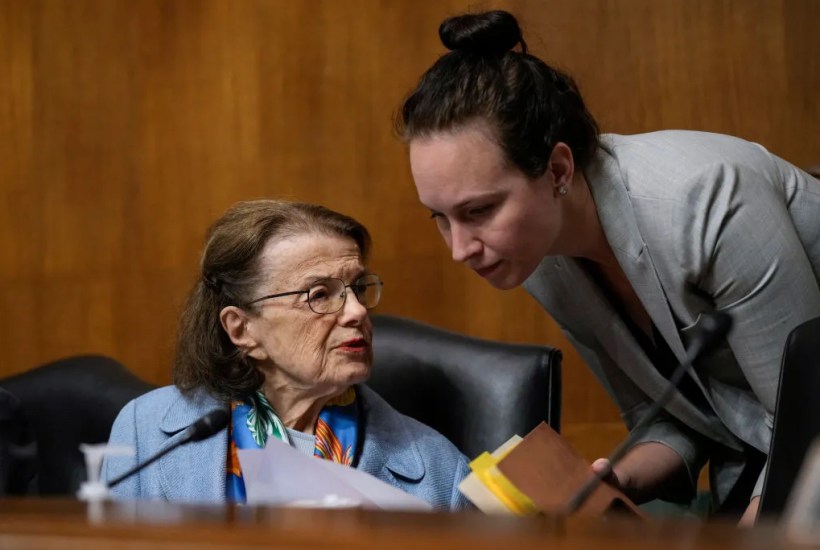Last week, Senate Minority Leader Mitch McConnell froze in place and was unable to answer questions for an agonizing period. The incident raised concerns about both his age (eighty-one) and health. But it should spark a larger debate about the gerontocracy that sits atop America’s government.
In January, the Pew Research Center reported that the Senate’s median age is now 65.3 years old. That’s up from 62.4 years old as recently as 2017, the first year of the Trump presidency. More senators have been eligible for Social Security than not for years.
Just this Monday, an Associated Press poll found 77 percent of Americans think eighty-year-old President Biden is too old to effectively govern in a second term. That included 69 percent of all Democrats. (A 51 percent majority felt Donald Trump’s age would prevent him from serving effectively, including 28 percent of Republicans.)
Growing public concern about aged leaders who refuse to leave the stage with dignity intact is fielded by a Congress which seems frozen in a bygone era — and which lacks the experience to tackle modern problems.
This was illustrated during this year’s congressional hearings on Facebook and TikTok, in which CEOs had to explain to members how WiFi works. In another humiliating moment, the late senator Orrin Hatch — in office for forty-two years — questioned how Facebook could exist as a business without charging its customers. Mark Zuckerberg’s response? “We run ads.”
Congressional hearings have become advertisements for term limits. Holding up waxen statues, such as ninety-year-old California senator Dianne Feinstein, as models of statesmanship is no longer defensible. But the infirmities on display in public may only be the tip of the iceberg.
Mike Kim, owner of Grubb’s Pharmacy in Washington, DC, told STAT News in 2017 that he routinely ships medication for Alzheimer’s disease and other forms of dementia to members on Capitol Hill through a contract he has with the Office of the Attending Physician of the United States Congress.
“It makes you kind of sit back and say, ‘Wow, they’re making the highest laws of the land and they might not even remember what happened yesterday,’” Kim said.
The same Associated Press poll showed that concern about the age of Biden and Trump reveals that the public are equally worried. “About two thirds of US adults back an age ceiling on candidates for president and Congress and a mandatory retirement age for justices,” the AP reports.
Indeed, North Dakota is likely to see a measure on next year’s ballot setting a congressional age limit of eighty for its delegation.
I believe a better approach is one that has already proven its enduring popularity with voters. In the early 1990s, activists used the initiative process to win passage of term limits on Congress in twenty-three states, without a single loss. Then in 1995, the Supreme Court ruled 5-4 that states cannot unilaterally impose term limits upon their own members. But term limits remain as popular as ever — and recent court cases have shown that even longstanding precedents can be overturned.
Senior members of Congress who have built donor networks that give them impregnable job security always raise the same tired arguments against term limits. They claim that under them, staff and bureaucrats would run the show. But is that not the case today? As senators born during the 1930s and 1940s grapple with lower energy and cognitive decline, a “staff infection” swoops in to plug the gaps.
The claim that term limits empower bureaucrats is absurd. Our current bureaucracy is the biggest in our history. It consists of 400-plus departments, agencies and sub-agencies, not to mention millions of employees. All of these programs were created, enabled and funded by a non-term-limited Congress. If we’re going to put anyone on trial for the crime of bureaucracy, it should be the career politicians who created it — not term-limited lawmakers.
The obvious obstacle to term limits is the refusal of Congress to limit itself. But the same opposition to change blocked the popular drive for the direct election of US senators. Then in 1913, enough pressure had built so Congress was forced to end the practice of having corrupt state legislatures select senators. The clinching argument? Senators were grandfathered in and none had to face voters until the end of their six-year term.
It is extremely unhealthy for our republic to allow a highly effective and popular reform like term limits to be held captive by members’ personal refusal to surrender power. With more evidence emerging each day, let’s put country first and pass term limits now.
The post Congress is growing ever older. It’s time to reconsider term limits appeared first on The Spectator World.
Got something to add? Join the discussion and comment below.
Get 10 issues for just $10
Subscribe to The Spectator Australia today for the next 10 magazine issues, plus full online access, for just $10.




















Comments
Don't miss out
Join the conversation with other Spectator Australia readers. Subscribe to leave a comment.
SUBSCRIBEAlready a subscriber? Log in